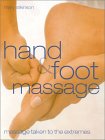|
 What to Look For in a Running Shoe
(8 simple criteria)
What to Look For in a Running Shoe
(8 simple criteria)
by Michael L. Hauser, Foot Specialist
Denver, Colorado
(This article is part of the Foot Health Series at A
Great Massage. See below for more articles about
feet and foot health.)
I have had numerous requests from my jogger patients
for some tips on picking a good running shoe. The following are some of the
more important things to consider when picking a running shoe for you.
1) Proper Fit:
-
Measurements for shoes should be taken while standing so that you and in
the full weight-bearing position.
-
The length of the foot should be measured from the heel
to the ball of the foot. Overall length (heel to toe) should be a secondary
measurement only.
-
Be sure that there is a 1/2" space between the longest
toe and the end of the toe box of the toe.
-
Check shoe width by grasping the shoe width above the the ball of the
foot and squeezing the shoe material between your fingers. If wriknles
appear, the shoe is too wide.
-
The heel should fit snugly, but not too tightly.
2) Sole Construction
Look for a shoe that has a touch outer sole with a soft layer above it.
This will provide both a long life for the shoe and at the same time give
good shock absorbing qualities. Be sure the sole is adequately thick from
heel to toe.
3) Sole flexibility
You should be able to bend the show at the ball of the foot to a 90 degree
angle by finger pressure against the front of the shoe.
4) Shank support
The sole of the shoe should be flush with the ground in the arch area.
5) Heel lift
Subtract the thickness of the sole at the ball of the foor from the heel
thickness. This should equal 1/2" or more.
6) Upper softness
Pick a material that will stay soft for the life of the shoe. Nylon is not
a good choice.
7) Heel counter
The heel should be rigid and cover the entire heel. It should also be
perpendicular to the supporting surface when viewed from the back of the
shoe.
8) Shoe weight
Pick a shoe that is compatible for its purpose -- light for racing and
heavier for training.
More
Resources
|




